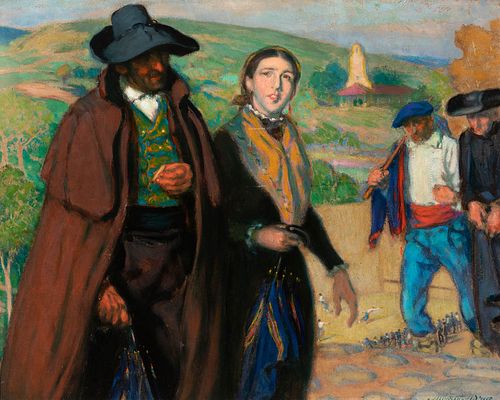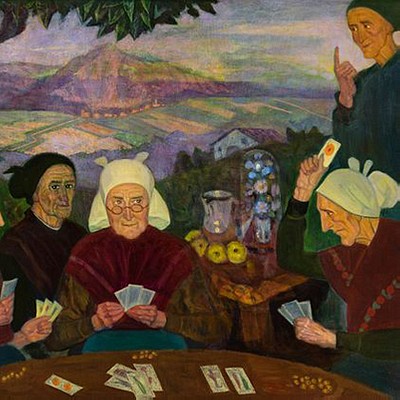ALBERTO ARRÚE VALLE (Bilbao, 1878 - 1944). "Basque costumbrista scene with ball game". Oil on canvas.
Lot 70
About Seller
Setdart Auction House
Carrer Aragó 346
Barcelona
Spain
Setdart Subastas was born in 2004 and is currently the first online art auction in Spain with solidity, prestige and reliability guaranteed by our more than 60,000 users. Setdart has a young, dynamic and enterprising team ready to successfully manage the purchase and sale of art works through custom...Read more
Estimate:
EUR€6,500 - EUR€7,000
$6,989.25 - $7,526.88
Absentee vs Live bid
Two ways to bid:
- Leave a max absentee bid and the platform will bid on your behalf up to your maximum bid during the live auction.
- Bid live during the auction and your bids will be submitted real-time to the auctioneer.
Bid Increments
| Price | Bid Increment |
|---|---|
| EUR€0 | EUR€10 |
| EUR€200 | EUR€25 |
| EUR€500 | EUR€50 |
| EUR€1,000 | EUR€100 |
| EUR€3,000 | EUR€200 |
| EUR€5,000 | EUR€500 |
| EUR€10,000 | EUR€1,000 |
| EUR€20,000 | EUR€2,000 |
| EUR€50,000 | EUR€5,000 |
About Auction
By Setdart Auction House
Dec 14, 2021
Set Reminder
2021-12-14 08:00:00
2021-12-14 08:00:00
America/New_York
Bidsquare
Bidsquare : 19th & 20th Century Fine Art
https://www.bidsquare.com/auctions/setdart-auction-house/19th-20th-century-fine-art-7992
Gaudi, Sorolla, Torres Garcia, Maclet, TSUGUHARU FOUJITA, Benjamin Palencia Setdart Auction House sofia@setdart.com
Gaudi, Sorolla, Torres Garcia, Maclet, TSUGUHARU FOUJITA, Benjamin Palencia Setdart Auction House sofia@setdart.com
- Lot Description
ALBERTO ARRÚE VALLE (Bilbao, 1878 - 1944). "Basque costumbrista scene with ball game". Oil on canvas. Signed in the lower right corner. Measurements: 37 x 58 cm; 64 x 79 cm (frame). Alberto Arrúe offers us in this canvas a magnificent group portrait that shows the interest of the painting and the Basque literature of the XIX century for the customs and the popular types. The artist presents us with a young couple in the foreground, followed by a chaplain and a pelotari. The four characters climb the slope of a mountain, like a pilgrimage. Behind this eloquent genre scene, we see an imposing landscape dotted with a church, executed with a very varied palette in which green tones predominate, very elaborate and varied. In the lower part of this panoramic view, going almost unnoticed, although in line with the narrative of the rest of the scene, Arrúe represents a Basque pelota court, with the players in full game and the public enjoying the match. The painter plays with the intensity and contrasts of light to construct the space, and attenuates the colors of the composition, reflecting the warm atmosphere that dominates the landscape. Brother of the other artists José, Ricardo and Ramiro, Alberto Arrúe began his training with Antonio María Lecuona, and later completed his studies at the School of Arts and Crafts with Guinea and Arámburu. In 1894 he was granted a scholarship to enter the Escuela Superior de Bellas Artes de San Fernando in Madrid, and later made study trips to Rome, Paris, Marseilles, London, Bordeaux and Argentina. Arrúe specialized in portraying the characters and customs of the Basque Country, and showed his work in official exhibitions such as the National Exhibitions of Fine Arts held in Madrid (1901 and 1904), the IV Exhibition of Modern Art in Bilbao (1906), the Hispano-French Exhibition in Zaragoza (1919), the I Exhibition of Painting and Sculpture in Bilbao (1919) and the Exhibition of Spanish Painting in London (1920). He also showed his work in galleries in Bordeaux (1920) and Buenos Aires (1922 and 1928), among other cities, including an important personal exhibition held in Bilbao in 1943, a year before his death. He is currently represented in the Provincial Museum of Vitoria and the Provincial Council of Bizkaia, among other public and private collections.
- Shipping Info
-
In-house shipping available. Please inquire at admin@setdart.com.
-
- Buyer's Premium



 EUR
EUR CAD
CAD AUD
AUD GBP
GBP MXN
MXN HKD
HKD CNY
CNY MYR
MYR SEK
SEK SGD
SGD CHF
CHF THB
THB
















